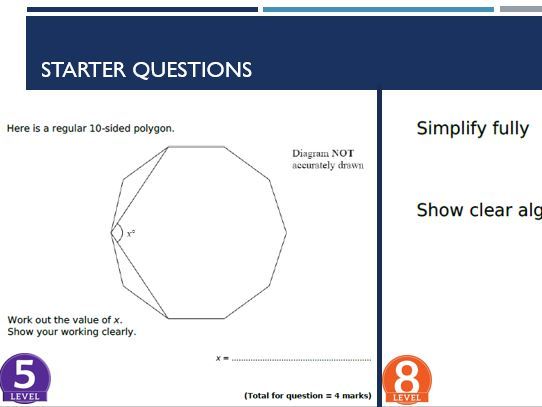
42Uploads
16k+Views
7k+Downloads
All resources

IB Maths Analysis and Approaches SL: Rational Functions
The following contains PowerPoint goes through the following:
-the reciprocal function
-recap some transformations which has been learnt earlier
-horizontal and vertical asymptotes (vertical asymptotes have been mentioned earlier when students learnt domain and range)
-sketching rational functions looking at end behaviours
-finding horizontal asymptotes by taking the limit and by making x the subject (2 methods)
-solving algebraic fractions
-inverse functions
-application questions
The PowerPoints have worked examples, and student exercises. I have also put in past paper exam questions for each topic. There are also links to videos and inter-actives throughout.

GCSE 9-1 Maths Starters (Target Grades 4-6)
20 Maths starters for targeting grades 4 - 6 on a Higher Paper. Also works well if teaching a boarder line class with a few students writing the Foundation Exam. Most starters have complete solutions. Questions are taken from various Edexcel Exam papers and contains questions from levels 4 - 9. Certain higher level questions are given for students to transfer their skills and obtain some of the marks.

GCSE 9-1 Maths Higher Level Starters (Target 8-9)
The following starter questions are for students targeting grades 7-9. Questions are taken from various exam boards and include solutions. Encourages students to think and apply their skills in different contexts. Entire PowerPoint includes over 50 questions in the following categories:
Coordinate Geometry - Circles
Geometric Problems and Proof
Algebraic Proof
Trigonometry
Inequalities
Functions
Coordinate Geometry – Lines & Curves
Sequences
Algebraic Problems – including ratio
Indices and Surds
Statistics
Extra

IB Maths Applications and Interpretation SL: Chapter 2 - Representing Space
The PowerPoint covers the complete content of Chapter 2 of the Oxford textbook. I have also added a few extension topics which build upon what students are learning and will be useful further in the course. Topics cover in the PowerPoint include:
The sine law
* the ambiguous case
The cosine law
Area of non-right angle triangles
Algebraic triangle problems
3D Problems involving non-right angle triangles
Area of sectors
Area of Segments
3D shapes
* surface area
* volume
* writing expressions
* algebraic problems
* capacity
There are also Past Paper questions embedded into the lesson along with various GeoGebra and Desmos interactive activities.

Higher GCSE Maths Starters (Target 5 - 9)
Th bundle contains 32 days worth of starters. Each stater comprises of 2 questions. One being of level 4 or 5 and the other of level 7 to 9. The idea is that students will practice both questions from the beginning and ending of the exam. I find higher level students tend to make mistakes early of in the exam and this allows them to practice these types of questions in class. Thus helping to improve results.

Trigonometry - Tree Measuring
The following activity will allow students to use their knowledge on trigonometry along with applications on their phone and computer to estimate the height of the tree. The students will use 3 different methods to measure the height of a tree and at the end will comment on which method is the most accurate assuming the last method is the closest estimate.
Students really enjoyed going outside and applying their skills to this task. This activity is a great investigation for those looking to move in the the IB BP program.

IB Maths Applications and Interpretation SL: Optimisation
The following lesson goes through the following:
-Optimisation without calculus
-The second derivative
-Optimisation with calculus
The lesson contains worked examples along with IB practice problems.

IB Maths Applications and Interpretation SL: Functions - Quadratics and Cubic
The following presentation was created for the Applications and Interpretations SL course following the order of teaching for the Kognity textbook but can also be used with the Pearson or Oxford textbook.
The PowerPoint goes through the following:
-recaps domain and range
-recaps x- and y-intercepts
-recaps asymptotes
-how to use the GDC to sketch functions and find domain and range
-how to find x-intercepts
-composite functions
-operations with functions (addition, subtraction, multiplication and division)
-what is a a Power function?
-leading coefficient
-even and odd degree polynomials
-quadratic functions - all 3 forms (standard, factored, and vertex form)
-axis of symmetry
-finding equations from graphs
-application questions
-cubic functions
-inverse cubic functions
-sketching both quadratic and cubic graphs
-finding equations of cubic graphs
-application question with cubic functions
Throughout the PowerPoint there are worked examples along with exercises for students. I have also included a few Desmos and Geogebra interactive links to help students get a better understanding of the concepts through visuals. At the end of each section I have included IB exam questions so students get get practice to the types and style of questioning they should expect to see when they write their exams. I also have included a few thinking questions, a few taken from American SAT exams. There are also links to YouTube videos to help students understanding with certain questions.

IB Maths Analysis and Approaches SL: Normal Distribution
The following contains PowerPoint goes through the following:
-the normal distribution curve
-calculating probabilities with and without technology
-the standard normal distribution
-calculating probabilities using z-score
-using the inverse function
-finding unknown mean and standard deviation
The PowerPoints have worked examples, and student exercises. I have also put in past paper exam questions for each topic. There are also links to videos and inter-actives throughout.

IB Maths Applications and Interpretation SL: Jeopardy Revision Game
The following activity is a great way to spend last couple days revising.
The game has all the music and sounds like the real game.

IB Maths Analysis and Approaches SL: Quadratic Functions
The following contains 3 PowerPoints which go through the following.
PPT1
-what is a quadratic function?
-key features of a parabola
-factoring and solving quadratics
-axis of symmetry
-understanding the 3 forms of a quadratic
-completing the square (vertex form)
-sketching quadratics
-finding equations of quadratic functions
PPT2
-quadratic inequalities
PPT3
-the quadratic formula and the discriminant
The PowerPoints have worked examples, and student exercises. I have also put in past paper exam questions for each topic.

IB Maths Applications and Interpretation SL: Arithmetic Sequences & Series
The Following presentation was created for the Applications and Interpretations SL course but can be used for any course such as A-levels that teach this topic. I have included exam question from both A-Level and the IB in the Presentation.
The PowerPoint goes through the following:
-linear sequences from GCSE
-the nth term formula
-embedded simultaneous equation problems
-inequality problems
-introduction to series and proof
-both forms of writing the sum formula
-sum problems involving inequalities
-sigma notation
-basic summation properties
Throughout the PowerPoint there are worked examples along with exercises for students. I have also included a few video exam solutions with videos going through addition examples for students. There is also a video explain how the Arithmetic Sum formula evolved. At the end of each section I have included IB exam questions so students get get practice to the types and style of questioning they should expect to see when they write their exams.

IB Maths Analysis and Approaches SL: Jeopardy Revision Game
This game is intended for an EOY 12 Exam.
Units covered during the year were Number & Algebra, Functions, and Statistics and Probability. There is no probability questions in this game.
The game has all the music and sounds like the real game on TV. Students really enjoy it.

IB Maths Analysis and Approaches SL: Transformations
The following lesson goes through the following:
-translations
-enlargements (vertical and horizontal)
-reflections (both axis)
-parent functions
The PowerPoint has worked examples, and student exercises. I have also put in past paper exam questions for each topic. The idea of this lesson is for students to understand transformations and apply it to any function, hence why I talk about different parent functions (base curves).

Linear Functions - Straight Line Graph Quizzes
The following are 5 quizzes created for online teaching through Microsoft Teams. All 5 quizzes are multiple choice, so self marking. The 5 quizzes cover the entire topic of linear functions which are as follow:
Straight Line Graphs; graphing, finding an equation, finding gradient, interpreting equation, rearranging equations (25 questions)
Parallel and Perpendicular Lines (19 questions)
Modelling Linear Functions – Real Life Graphs (14 questions)
Distance and Midpoint (10 questions)
Equations of Perpendicular Bisectors (5 questions)

Embedded Linear Simultaneous Equations
30+ linear simultaneous equation problems. The PowerPoint starts with a quick recap on how to solve using either substitution or elimination. Most problems require students to transfer skills from other contexts in order to solve the problem. Problems include, linear and quadratic sequence, equations of quadratic graphs, angle properties, equation of a line, area and perimeter, index rules, HCF & LCM, pressure and density, etc.

Common Factoring - Introductory Lesson
The Following lesson introduces the concept of common factoring through numerical calculators where students find quicker and easier ways to mental calculator sums through the use of common factoring. It then moves on to algebraic factoring with visual displays (algebraic tiles) and finishes with piecewise factoring. The idea is to move from piecewise factoring onto expanding double brackets.

GCSE 9-1 Maths Must Know Topics
Lesson 1: Quadratic Sequences
Lesson 2: Completing the Square
Lesson 3: Iteration
Lesson 4: Composite Functions
Each lesson includes worked examples and practice questions. Alternative methods are shown for completing the square. Iteration lesson includes a video and graphical representation of how iteration works to deepen student understanding.

IB Maths Applications and Interpretation SL: Chapter 4 - Dividing Up Space
The PowerPoint follows chapter 4 from the Oxford textbook. There are worked examples, student exercises and past paper exam questions for each section. I have also embedded links to various Youtube, GeoGebra and Desmos activities and visuals to help improve student understanding. The PowerPoint contains the following content:
recap piecewise functions
the number plane
distance between 2 points (2D & 3D)
midpoint (2D & 3D)
classifying triangles given coordinates
coordinate geometry in 3D space
gradients
different forms of an equation of a line
points of intersection
parallel and perpendicular lines
collinear points
perpendicular bisectors
shortest distance to a line

Angry Birds: Quadratics Project
Here is a great activity to do as a group, pairs or individually. I haven’t created it but wanted to share it with others. This activity looks at quadratics given in different forms; table of values, graphically, in words, and in standard form. The idea is to see which birds hit the pigs. There are 5 versions of this activity which is great. Students don’t need to know about vertex form (completing the square) for this activity, but do need to understand that the axis of symmetry is half way between the roots.




















